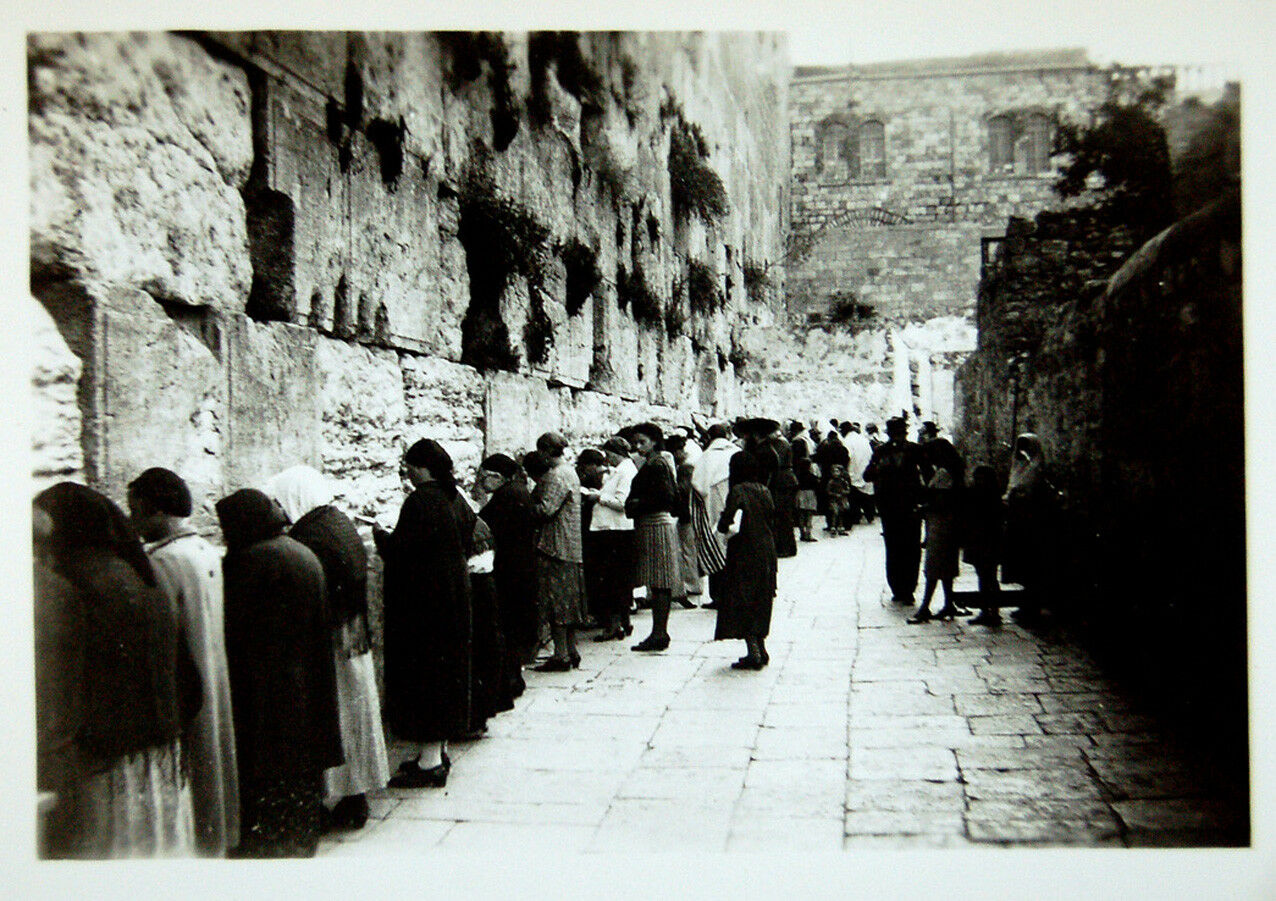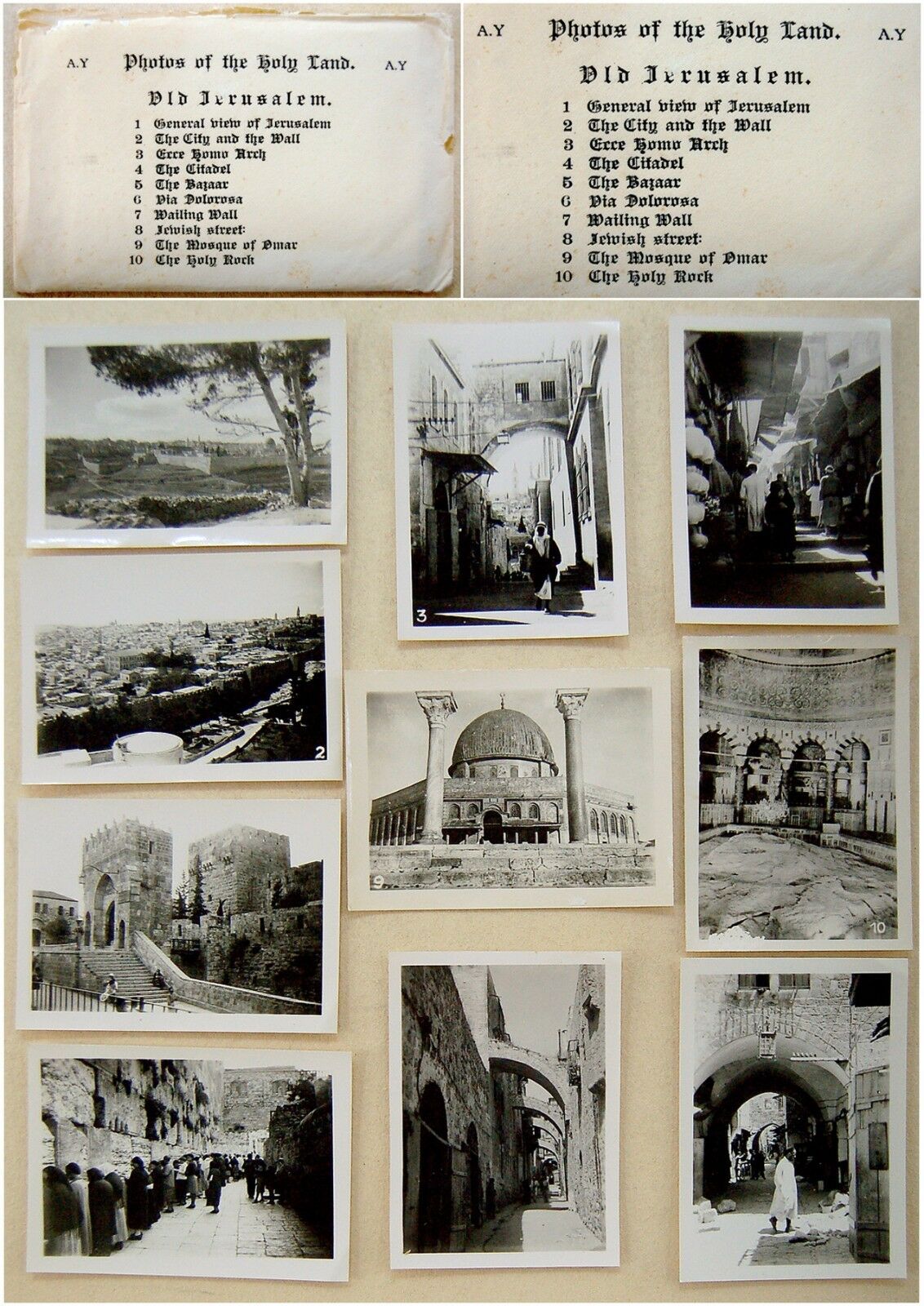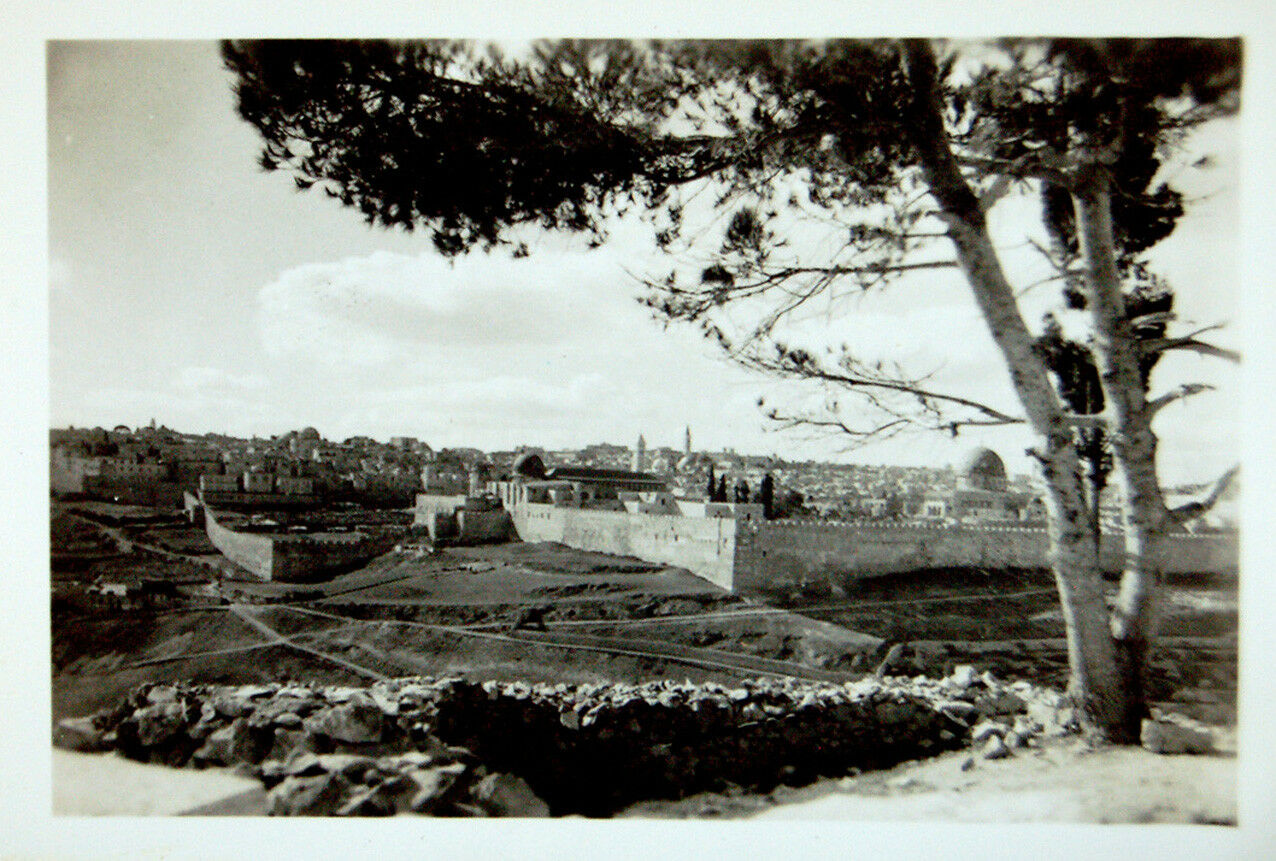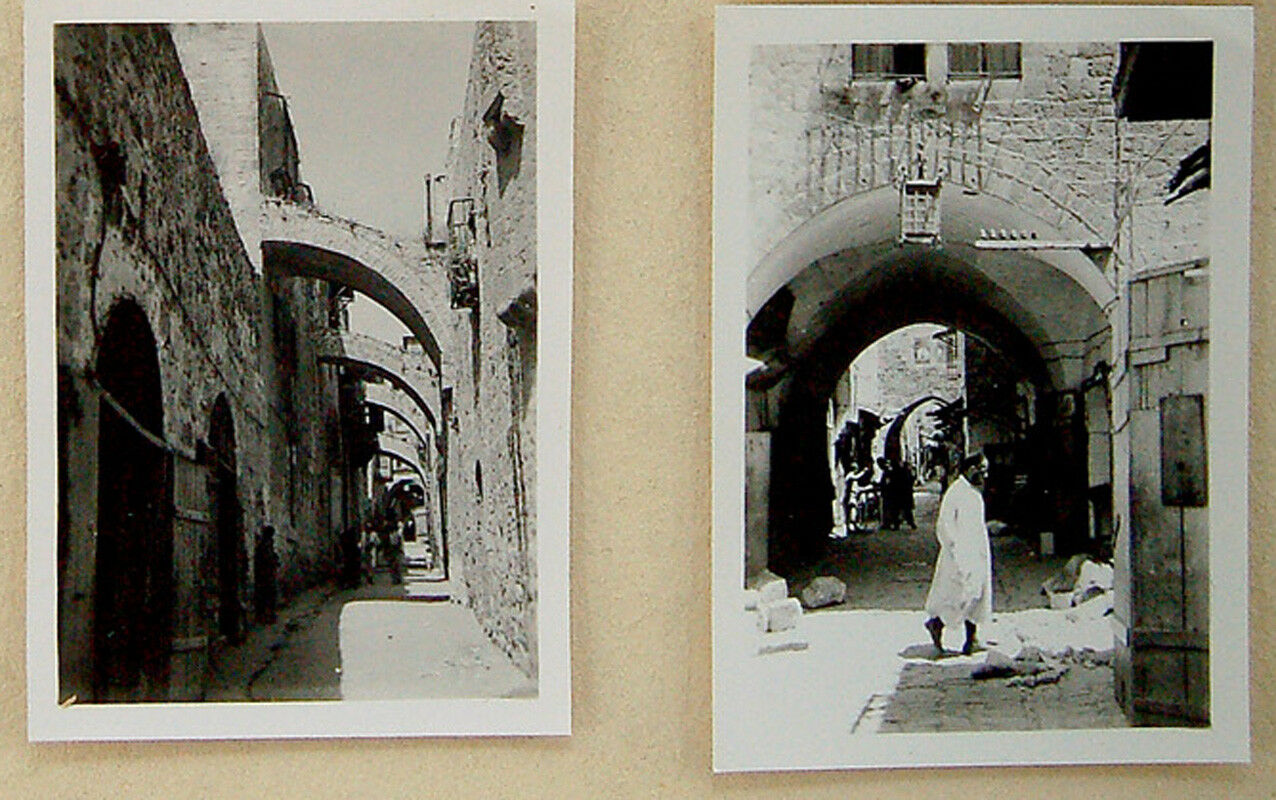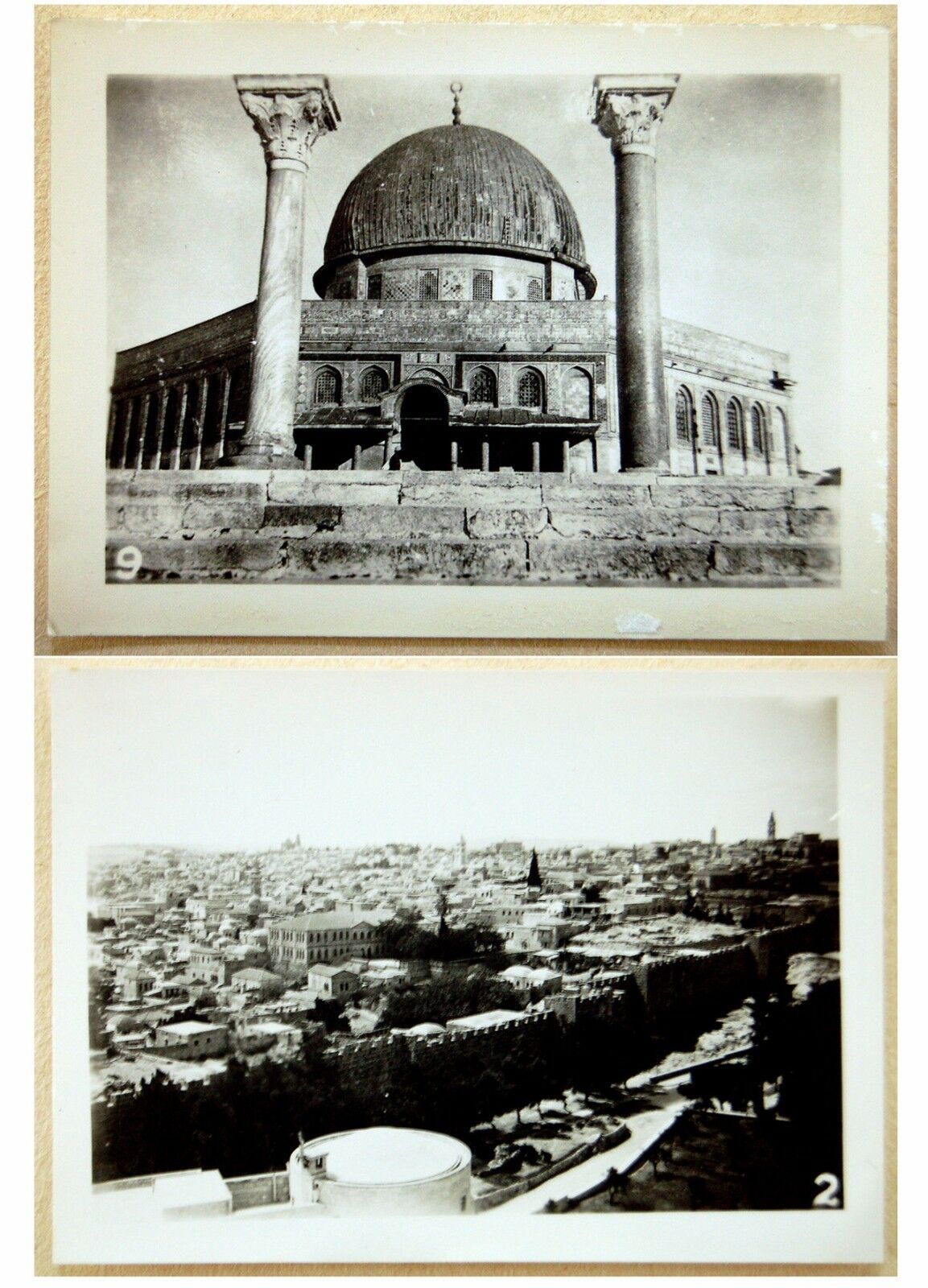-40%
1930 Palestine 10 PHOTOS Israel JERUSALEM TEMPLE MOUNT Wailing WALL - Al AQSA
$ 51.55
- Description
- Size Guide
Description
DESCRIPTION: Up for sale is an original ca 70-80- years SERIE of TEN SNAP PHOTOS ( Snapshots ) of the olld city of Jerusalem in Eretz Israel ( Palestine ) which was photographed and published in ca 1930-40's . These are ORIGINAL SILVER GELATINE PHOTOS ( Not reprints ) . They depict the TEMPLE MOUNT , The WESTERN - WAILING WALL ( The KOTEL , HaKotel Hama'aravi ) , The JEWISH STREETS of OLD JERUSALEM , The VIA DOLOROSA , Haram - Es - Sharif , The MOSQUE of OMAR , The DOME of the ROCK . A FINE JEWISH - HEBREW - JUDAICA item , Relevant also to Islam, Islamic , Arab, Arabic etc.TEN photos. With it's original envelope as was issued by the publisher . Around 3 x 4.5".
Excellent unused condition of the photos. Strong wear of the original envelope.
(
Pls look at scan for accurate AS IS images ) Will be sent rolled in a special protective rigid sealed package.
AUTHENTICITY
:
The set of photos is ORIGINAL from
ca 1930-40's
. It is NOT a reproduction or a recently made reprint or an immitation , It holds a life long GUARANTEE for its AUTHENTICITY and ORIGINALITY.
PAYMENTS
:
Payment method accepted : Paypal.
SHIPPMENT
: SHIPP worldwide via registered airmail is . Will be sent inside a protective package .
Handling around 5 days after payment.
Jerusalem (
Hebrew:
יְרוּשָׁלַיִם
Yerushaláyim
; Arabic:
القُدس
al-Quds
) is the capital of Israel, though not internationally recognized as such, and one of the oldest cities in the world. It is located in the Judean Mountains, between the Mediterranean Sea and the northern edge of the Dead Sea. It is Israel's largest city in both population and area, if East Jerusalem is included, with a population of 801,000 residents
over an area of 125.1 km (48.3 sq mi).Jerusalem is also a holy city to the three major Abrahamic religions—Judaism, Christianity and Islam. During its long history, Jerusalem has been destroyed twice, besieged 23 times, attacked 52 times, and captured and recaptured 44 times. The oldest part of the city was settled in the 4th millennium BCE.In 1538, walls were built around Jerusalem under Suleiman the Magnificent. Today those walls define the Old City, which has been traditionally divided into four quarters—known since the early 19th century as the Armenian, Christian, Jewish, and Muslim Quarters. The Old City became a World Heritage site in 1981, and is on the List of World Heritage in Danger. Modern Jerusalem has grown far beyond its boundaries. Jerusalem has been the holiest city in Jewish tradition since, according to the Hebrew Bible, King David of Israel first established it as the capital of the united Kingdom of Israel in c. 1000 BCE, and his son, King Solomon, commissioned the building of the First Temple in the city. In Christian tradition, Jerusalem has been a holy city since, according to the New Testament, Jesus was crucified there, possibly in c. 33 CE, and 300 years later Saint Helena identified the pilgrimage sites of Jesus' life. In Sunni Islam, Jerusalem is the third-holiest city, after Mecca and Medina, whereas Shiite (Shia) Muslims consider Najaf in Iraq the third holiest city followed by Karbala. In Islamic tradition in 610 CE it became the first Qibla, the focal point for Muslim prayer (Salah), and Muhammad made his Night Journey there ten years later, ascending to heaven where he speaks to God, according to the Quran.As a result, despite having an area of only 0.9 square kilometres (0.35 sq mi), the Old City is home to many sites of tremendous religious importance, among them the Temple Mount and its Western Wall, the Church of the Holy Sepulchre, the Dome of the Rock and al-Aqsa Mosque. Today, the status of Jerusalem remains one of the core issues in the Israeli–Palestinian conflict During the 1948 Arab-Israeli War, West Jerusalem was among the areas captured and later annexed by Israel while East Jerusalem, including the Old City, was captured and later annexed by Jordan. Israel captured East Jerusalem from Jordan during the 1967 Six-Day War and subsequently annexed it. Currently, Israel's Basic Law refers to Jerusalem as the country's "undivided capital". The international community has rejected the latter annexation as illegal and treats East Jerusalem as Palestinian territory occupied by Israel The international community does not recognize Jerusalem as Israel's capital, and the city hosts no foreign embassies. According to the Palestinian Central Bureau of Statistics, 208,000 Palestinians live in East Jerusalem, which is sought by the Palestinian Authority as the capital of a future
Palestinian state. All branches of the Israeli government are located in Jerusalem, including the Knesset (Israel's parliament), the residences of the Prime Minister and President, and the Supreme Court. Jerusalem is home to the Hebrew University and to the Israel Museum with its Shrine of the Book. The Jerusalem Biblical Zoo has ranked consistently as Israel's top tourist attraction for Israelis. The Temple Mount, known in Hebrew (and in Judaism) as Har haBáyit (Hebrew:
הַר הַבַּיִת
) and in Arabic (and in Islam) as the Haram Ash-Sharif (Arabic:
الحرم القدسي الشريف
,
al-haram al-qudsī ash-sharīf
,
Noble Sanctuary
), is one of the most important religious sites in the Old City of Jerusalem. It has been used as a religious site for thousands of years. At least four religions are known to have used the Temple Mount: Judaism, Christianity, Roman religion, and Islam. Biblical scholars have often identified it with two biblical mountains of uncertain location: Mount Moriah where the binding of Isaac took place, and Mount Zion where the original Jebusite fortress stood; however, both interpretations are disputed. Judaism regards the Temple Mount as the place where God chose the Divine Presence to rest (Isa 8:18); according to the rabbinic sages whose debates produced the Talmud, it was from here the world expanded into its present form and where God gathered the dust used to create the first man, Adam. The site is the location of Abraham's binding of Isaac, and of two Jewish Temples. According to the Bible the site should function as the center of all national life—a governmental, judicial and, of course, religious center (Deut 12:5-26; 14:23-25; 15:20; 16:2-16; 17:8-10; 26: 2; 31: 11; Isa 2: 2-5; Oba 1:21; Psa 48). During the Second Temple Period it functioned also as an economical center. From that location the word of God will come out to all nations, and that is the site where all prayers are focused. According to Jewish tradition and scripture (2 Chronicles 3:1-2), the first temple was built by Solomon the son of David in 957 BCE and destroyed by the Babylonians in 586 BCE. The second was constructed under the auspices of Zerubbabel in 516 BCE and destroyed by the Roman Empire in 70 CE. Jewish tradition maintains it is here the Third and final Temple will also be built. The location is the holiest site in Judaism and is the place Jews turn towards during prayer. Due to its extreme sanctity, many Jews will not walk on the Mount itself, to avoid unintentionally entering the area where the Holy of Holies stood, since according to Rabbinical law, some aspect of the Divine Presence is still present at the site. It was from the Holy of Holies that the High Priest communicated directly with God. Among Sunni Muslims, the Mount is widely considered the third holiest site in Islam. Revered as the Noble Sanctuary (Bait-ul-Muqaddas) and the location of Muhammad's journey to Jerusalem and ascent to heaven, the site is also associated with Jewish biblical prophets who are also venerated in IslamAfter the Muslim conquest of Jerusalem in 637 CE, Umayyad Caliphs commissioned the construction of the al-Aqsa Mosque and Dome of the Rock on the site. The Dome was completed in 692 CE, making it one of the oldest extant Islamic structures in the world, after the Kaabah. The Al Aqsa Mosque rests on the far southern side of the Mount, facing Mecca. The Dome of the Rock currently sits in the middle, occupying or close to the area where the Bible mandates the Holy Temple be rebuilt.In light of the dual claims of both Judaism and Islam, it is one of the most contested religious sites in the world. Since the Crusades, the Muslim community of Jerusalem has managed the site as a Waqf, without interruption.
As part of the Old City, controlled by Israel since 1967, both Israel and the Palestinian Authority claim sovereignty over the site, which remains a major focal point of the Arab-Israeli conflict. In an attempt to keep the status quo, the Israeli government enforces a controversial ban on prayer by non-Muslim visitors.
The Temple Mount, known in Hebrew (and in Judaism) as Har haBáyit (Hebrew: הַר הַבַּיִת) and in Arabic (and in Islam) as the Haram al-Sharif (Arabic: الحرم القدسي الشريف, al-haram al-qudsī ash-sharīf, Noble Sanctuary), is one of the most important religious sites in the Old City of Jerusalem. It has been used as a religious site for thousands of years. At least four religions are known to have used the Temple Mount: Judaism, Christianity, Roman religion, and Islam. Biblical scholars have often identified it with two biblical mountains of uncertain location: Mount Moriah where the binding of Isaac took place, and Mount Zion where the original Jebusite fortress stood; however, both interpretations are disputed. Judaism regards the Temple Mount as the place where God chose the Divine Presence to rest (Isa 8:18); according to the rabbinic sages whose debates produced the Talmud, it was from here the world expanded into its present form and where God gathered the dust used to create the first man, Adam. The site is the location of Abraham's binding of Isaac. According to the Bible, two Jewish Temples stood at the Temple Mount, though there is no proof for the first temple.[2] According to the Bible the site should function as the center of all national life—a governmental, judicial and, of course, religious center (Deut 12:5-26; 14:23-25; 15:20; 16:2-16; 17:8-10; 26: 2; 31: 11; Isa 2: 2-5; Oba 1:21; Psa 48). During the Second Temple Period it functioned also as an economical center. From that location the word of God will come out to all nations, and that is the site where all prayers are focused. According to Jewish tradition and scripture (2 Chronicles 3:1-2), the first temple was built by Solomon the son of David in 957 BCE and destroyed by the Babylonians in 586 BCE. The second was constructed under the auspices of Zerubbabel in 516 BCE and destroyed by the Roman Empire in 70 CE. Jewish tradition maintains it is here the Third and final Temple will also be built. The location is the holiest site in Judaism and is the place Jews turn towards during prayer. Due to its extreme sanctity, many Jews will not walk on the Mount itself, to avoid unintentionally entering the area where the Holy of Holies stood, since according to Rabbinical law, some aspect of the Divine Presence is still present at the site.[3] It was from the Holy of Holies that the High Priest communicated directly with God. Among Sunni Muslims, the Mount is widely considered the third holiest site in Islam. Revered as the Noble Sanctuary (Bait-ul-Muqaddas) and the location of Muhammad's journey to Jerusalem and ascent to heaven, the site is also associated with Jewish biblical prophets who are also venerated in Islam[citation needed]. After the Muslim conquest of Jerusalem in 637 CE, Umayyad Caliphs commissioned the construction of the al-Aqsa Mosque and Dome of the Rock on the site.[4] The Dome was completed in 692 CE, making it one of the oldest extant Islamic structures in the world, after the Kaabah. The Al Aqsa Mosque rests on the far southern side of the Mount, facing Mecca. The Dome of the Rock currently sits in the middle, occupying or close to the area where the Bible mandates the Holy Temple be rebuilt.[5] In light of the dual claims of both Judaism and Islam, it is one of the most contested religious sites in the world. Since the Crusades, the Muslim community of Jerusalem has managed the site as a Waqf, without interruption.[6] As part of the Old City, controlled by Israel since 1967, both Israel and the Palestinian Authority claim sovereignty over the site, which remains a major focal point of the Arab-Israeli conflict.[7] In an attempt to keep the status quo, the Israeli government enforces a controversial ban on prayer by non-Muslim visitors. The Old City (Hebrew: העיר העתיקה, Ha'Ir Ha'Atiqah, Arabic: البلدة القديمة, al-Balda al-Qadimah, Armenian: Հին Քաղաք, Hin K'aghak' ) is a 0.9 square kilometers (0.35 sq mi) walled area[3] within the modern city of Jerusalem. Until 1860, when the Jewish neighborhood, Mishkenot Sha'ananim, was established, this area constituted the entire city of Jerusalem. The Old City is home to several sites of key religious importance: the Temple Mount and its Western Wall for Jews, the Church of the Holy Sepulchre for Christians, and the Dome of the Rock and al-Aqsa Mosque for Muslims. It was added to the UNESCO World Heritage Site List in 1981. Traditionally, the Old City has been divided into four uneven quarters, although the current designations were introduced only in the 19th century.[4] Today, the Old City is roughly divided into the Muslim Quarter, the Christian Quarter, the Jewish Quarter and the Armenian Quarter. Following the 1948 Arab-Israeli War, the Old City was captured by Jordan and the Jewish residents were evicted. During the Six-Day War in 1967, which saw hand to hand fighting on the Temple Mount, Israel captured the Old City alongside the rest of East Jerusalem, subsequently annexing them to Israeli territory and reuniting them with the western part of the city. Today, Israel controls the entire area, which it considers part of its national capital. In 2010, Jerusalem's oldest fragment of writings was found outside of the Old City's walls.[5] The Jerusalem Law of 1980 effectively annexing East Jerusalem to Israel was declared by UN Security Council Resolution 478 null and void and East Jerusalem is regarded by some in the international community as part of the occupied Palestinian territory. Jerusalem Hebrew: יְרוּשָׁלַיִם Yerushaláyim ; Arabic: القُدس al-Quds located on a plateau in the Judean Mountains between the Mediterranean and the Dead Sea, is one of the oldest cities in the world. It is considered holy to the three major Abrahamic religions—Judaism, Christianity and Islam. Israelis and Palestinians both claim Jerusalem as their capital, as Israel maintains its primary governmental institutions there and the State of Palestine ultimately foresees it as its seat of power; however, neither claim is widely recognized internationally. During its long history, Jerusalem has been destroyed twice, besieged 23 times, attacked 52 times, and captured and recaptured 44 times.[2] The oldest part of the city was settled in the 4th millennium BCE.[3] In 1538, walls were built around Jerusalem under Suleiman the Magnificent. Today those walls define the Old City, which has been traditionally divided into four quarters—known since the early 19th century as the Armenian, Christian, Jewish, and Muslim Quarters.[4] The Old City became a World Heritage site in 1981, and is on the List of World Heritage in Danger.[5] Modern Jerusalem has grown far beyond the Old City's boundaries. According to the Biblical tradition, King David established the city as the capital of the united Kingdom of Israel and his son, King Solomon, commissioned the building of the First Temple; there is no archaeological evidence that Solomon's Temple existed or any record of it, other than the Bible.[6] These foundational events, straddling the dawn of the Ist Millennium BCE, assumed central symbolic importance for the Jewish People.[7] The sobriquet of holy city (עיר הקודש, transliterated ‘ir haqodesh) was probably attached to Jerusalem in post-exilic times.[8][9][10] The holiness of Jerusalem in Christianity, conserved in the Septuagint[11] which Christians adopted as their own authority,[12] was reinforced by the New Testament account of Jesus's crucifixion there. In Sunni Islam, Jerusalem is the third-holiest city, after Mecca and Medina.In Islamic tradition in 610 CE it became the first Qibla, the focal point for Muslim prayer (salat ), and Muhammad made his Night Journey there ten years later, ascending to heaven where he speaks to God, according to the Quran.[16][17] As a result, despite having an area of only 0.9 square kilometres (0.35 sq mi),[18] the Old City is home to many sites of seminal religious importance, among them the Temple Mount and its Western Wall, the Church of the Holy Sepulchre, the Dome of the Rock and al-Aqsa Mosque. Today, the status of Jerusalem remains one of the core issues in the Israeli–Palestinian conflict. During the 1948 Arab-Israeli War, West Jerusalem was among the areas captured and later annexed by Israel while East Jerusalem, including the Old City, was captured and later annexed by Jordan. Israel captured East Jerusalem from Jordan during the 1967 Six-Day War and subsequently annexed it. Currently, Israel's Basic Law refers to Jerusalem as the country's "undivided capital". The international community has rejected the latter annexation as illegal and treats East Jerusalem as Palestinian territory occupied by Israel.[19][20][21][22] The international community does not recognize Jerusalem as Israel's capital, and the city hosts no foreign embassies. According to the Palestinian Central Bureau of Statistics, 208,000 Palestinians live in East Jerusalem, which is sought by the Palestinian Authority as the capital of Palestine.[23][24][25] All branches of the Israeli government are located in Jerusalem, including the Knesset (Israel's parliament), the residences of the Prime Minister and President, and the Supreme Court. Jerusalem is home to the Hebrew University and to the Israel Museum with its Shrine of the Book. ebay4050
